Zahra Newman’s transcendent tribute to jazz legend Billie Holiday
By Cameron Woodhead, Jessica Nicholas and Tony Way
THEATRE
Lady Day at Emerson’s Bar & Grill
★★★★★
Melbourne Theatre Company, Arts Centre Melbourne, until December 2
A transcendent tribute to Billie Holiday, Lady Day at Emerson’s Bar & Grill invites us into an intimate live performance near the end of the jazz legend’s career.

Zahra Newman: Lady Day lives again in this tour de force.Credit: Matt Byrne
You need no small measure of audacity to channel a star as original as Holiday, and prodigious vocal and acting talent to be able to transfigure the art of impersonation from cheap trick into miraculous resurrection. Zahra Newman pulls off a rare feat. Lady Day lives again in this tour de force.
It’s a transfixing performance, drawn from the seemingly inextricable strands of Holiday’s musical brilliance and her anguished biography. Rita Dove might’ve said it best in her poem Canary:
Billie Holiday’s burned voice
had as many shadows as lights,
a mournful candelabra against a sleek piano,
the gardenia her signature under that ruined face.
Billie’s “burned voice” was wrested from a world of pain. She endured poverty and child abuse, discrimination and domestic violence, heroin addiction and imprisonment, and she died from cirrhosis at the age of 44, not long after the performance given in this play.
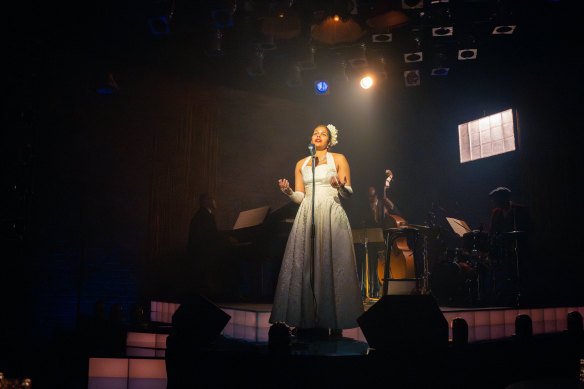
Zahra Newman as Billie Holiday ignites the memory of that burned voice.Credit: Matt Byrne
Newman sculpts a grim and moving portrayal of the fragility under the formidable voice. Her Holiday is jonesing for a fix barely halfway through and eventually nips into the wings to hit up, leaving her jazz trio – Kym Purling (piano), Dan Witton (bass), Edward York (drums) – to improvise a cover.
Anecdotes from her life are riffed upon with a loose, jazz-inspired coherence, and songs take flight when words flail. A carousing, devil-may-care vibe – which sees Billie drifting through cabaret tables singing Gimme a Pigfoot and a Bottle of Beer – yields to defiant melancholy and bruising songs of love and grief.
Lyrics often shine a light on oppressions condemned to silence. Freedom is given a cynical wink in Ain’t Nobody’s Business, which opens with a woman defending her abusive partner, and money’s heartless creed provokes a scathing lament in God Bless the Child.
And the immortal Strange Fruit – a necromantic threnody composed in rage and sorrow at the lynching of coloured men in the South – is sung here with devastating force in memory of Billie’s father, who died after racism denied him timely hospital treatment.
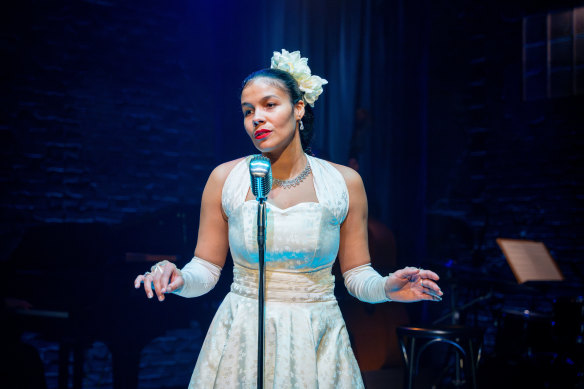
As Billie Holliday, Zahra Newman sings with devastating force.Credit: Matt Byrne
Charismatic whimsy fortifies the star against agonising social and personal demons. She forges a likeable, dissolute sort of bond with the audience, and at one point, her dog makes a cute cameo appearance. But the most riveting moments come through Newman’s ability to ignite the memory of that burned voice – those notes of flame that lick the air before diving back into the fire.
Conventional wisdom would have you believe Billie Holiday inimitable, so I’m not sure how Newman does it, but then, no explanation could fully account for the inspiration the star found in life’s cruelties, either. “If you can’t be free,” as Dove’s ode to her ends, “be a mystery.”
Reviewed by Cameron Woodhead
JAZZ
The Hot 8 Brass Band, Cheryl Durongpisitkul, Ingrid Jensen, Lisa Simone, Kendrick Scott and others
Melbourne International Jazz Festival, until October 29
As I stepped off the tram at Federation Square on Saturday afternoon, curious onlookers were peering over Princes Bridge to watch the joyful spectacle unfolding below them. The Hot 8 Brass Band and Horns of Leroy were leading a New Orleans-style street parade along the banks of the Yarra, gathering revellers as they strode through Southbank like exuberant Pied Pipers.

The Hot 8 Brass Band opened the Melbourne International Jazz Festival like exuberant Pied Pipers.Credit: Will Hamilton-Coates
The parade eventually wound its way to Fed Square, where the musicians strutted onto the stage as their funk-fuelled horns and percussion compelled the audience to dance.
This delightfully entertaining show was one of many events taking place across town during the opening weekend of this year’s Melbourne International Jazz Festival, emphasising the inclusiveness and accessibility of the festival program.
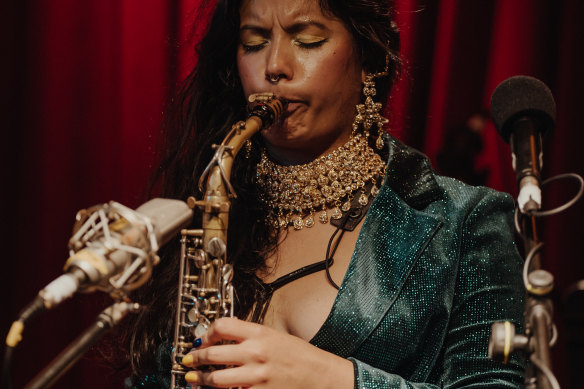
Cheryl Durongpisitkul at the Melbourne International Jazz Festival: Dissonance, melancholy and hope.Credit: Max Roux
The official opening concert was at Jazzlab on Friday night, when composer-saxophonist Cheryl Durongpisitkul premiered a powerful new suite, I Still Miss You. Divided into six movements, this deeply personal work explored trauma, loss, grief and healing with fearlessness and aching vulnerability. Durongpisitkul led a superb 12-piece ensemble through each intricate movement, variously conjuring moods of quiet unease, chaotic dissonance, tender melancholy and, finally, hope.
At the same venue the following night, Canadian trumpeter Ingrid Jensen took to the stage with a band featuring several local musicians she’d met just hours earlier. Her admiration for her onstage companions (Andrea Keller, Stephen Magnusson, Sam Anning and Felix Bloxsom) was palpable, and their ability to deftly interpret her compositions, gestures and body language allowed her to focus purely on the music. Her marvellously expressive trumpet issued bold exclamation marks, vigorous sweeps and introspective whispers, augmented by imaginative pedal and breath effects.
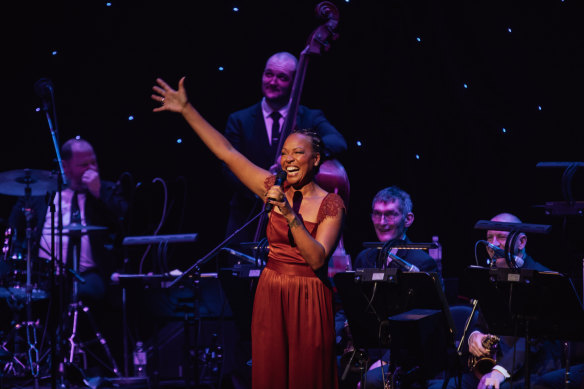
Lisa Simone displayed awe-inspring power at Hamer Hall.Credit: Will Hamilton-Coates
On Sunday afternoon, a sold-out Hamer Hall testified to the enduring legacy of Nina Simone, with a concert featuring the late singer’s daughter Lisa. Simone’s voice has a lighter, clearer tone than that of her mother, but she can dig into a phrase with bluesy vigour and sustain a single note with awe-inspiring power. Her interpretations of Nina’s songs somehow lacked fire in the early part of the show, but the energy and impact built as the concert progressed. Simone was at her most passionate singing her own song Finally Free, where she hinted at her desire to shrug off the burden of her musical inheritance.
Fire and passion were in abundant supply at Chapel Off Chapel later that evening, thanks to drummer Kendrick Scott and his virtuosic quintet. All five musicians are part of the acclaimed SFJAZZ Collective – also appearing at the festival – but this was an opportunity for Scott to showcase his compositional skills as well as his dazzling artistry at the kit. Creating visceral propulsion on some numbers, understated accompaniment on others, he beamed with pleasure as his remarkable colleagues brought his music to vivid, pulsating life.
Reviewed by Jessica Nicholas
MUSIC
Songs From A Strange Land ★★★★
The Song Company, Trinity College Chapel, October 23
Four hundred years may have passed since the death of composer William Byrd, but his experience as a Catholic outsider in Protestant England has left an enduring musical legacy. This legacy formed the impetus for an absorbing exploration of the music of exiles sung with polished commitment by the six members of The Song Company and guest director Christopher Watson.
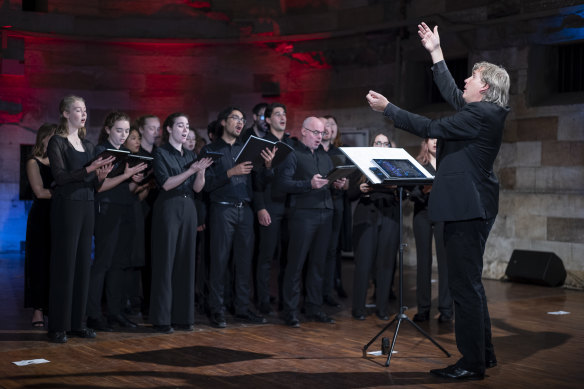
The Song Company: Intricate textures and plangent depths.Credit: Christopher Hayles
Setting a mournful mood, Byrd’s dark-hued Tristis et anxietas brought forth richly grained tone from the lower voices, complementing contemporary Australian expressions of dispossession in Paul Stanhope’s Longing and Joseph Twist’s How Shall We Sing in a Strange Land?
Stanhope and Twist each in their own way harness the intimacy of unaccompanied singing to telling emotional effect; their intricate textures intriguing the ear. In a similar vein, I want to live by American minimalist David Lang added another element of yearning to belong.
The plangent depths of Ye sacred muses, Byrd’s heartfelt tribute to his mentor Thomas Tallis were mirrored by the intense, post-modern harmonic spaces of Roxanna Panufnik’s Kyrie after Byrd. An enviable vocal blend in these works also served the harmonic richness of two works by Gabriel Jackson: In all his works and I shall gaze upon you.
Some light relief came with a simple but stylish account of Ah Robin, Gentle Robin by William Cornysh sung by the upper voices (Susannah Lawergren, Amy Moore and Jessica O’Donoghue), while the male voices (Timothy Reynolds, Hayden Barrington, James Fox and Watson) revelled in Pelle Gudmunsen-Holmgreen’s whimsically risque tale of courtly love, You and I and Amyas II.
Byrd’s monumental Tribue Domine set the seal on this satisfying program that made an excellent case for the wide-ranging appeal to heart and head of fine choral music delivered by a professional ensemble. May ensembles like The Song Company continue to flourish.
Reviewed by Tony Way
Find out the next TV, streaming series and movies to add to your must-sees. Get The Watchlist delivered every Thursday.